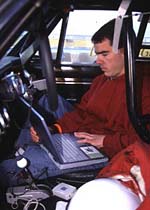|
<<
PREVIOUS PAGE
Generally, he set the timer to activate an
amount of retard just moments after the launch.
This gives an initial full shot of power to
the rear tires and suspension. The amount of
retard all depends on reading the track and
conditions. We heard it can range from 1-10
degrees but is usually all back in by the 60-foot
marker.
|

| Laptops are becoming
normal tools for racers and Richie
Kolb, who tunes Real Street Champ
Bruce Lagory's Barracuda does a lot
of tuning via his PC. Kolb pulls timing
out during the holeshot to soften
the blow of their 513ci BES engine. |
|
In the last few years, digital technology has
been incorporated into ignition controls, which
has opened a new world of tuning aspects to racers.
One of the most popular choices seems to be MSD
Programmable Digital-7 Ignition Control (PN 7530).
This unit is legal in all competition and is on
the majority of NHRA Pro Stock cars. This ignition
is programmable from a laptop PC and has step
retards like their accessories, but one unique
feature is a timing curve that can be used exclusively
during the holeshot.
There are two timing curves in the ignition
software; one is a run curve and the other is
a launch curve. The launch curve is only used
in first gear, and it is deactivated when there
is an rpm drop. This allows racers to plot a
timing curve designed to get the car out of
the hole. The timing can be retarded in 0.1-degree
increments for every 100 rpm from 800-12,000
rpm!
MSD also offers a retard that can be ramped
in over time during the launch. In this program
you set a retard amount that activates as soon
as the transbrake or clutch switch is released.
Then you set an amount of time that it takes
for the retard to ramp back to normal timing.
This is adjusted in 0.1-second increments and
is similar to the same affects of using a timer
to activate a step retard, except this ramps
the timing back in smoothly rather than abruptly
turning it off.

Chart courtesy MSD Ignitions
As you can see, there are several ways to tune-in
traction. Just like setting up an aggressive
clutch setting or taking away some boost pressure,
the ignition timing provides yet another window
of tuning opportunity. Though the racers we
talked with treated their exact retard amounts
like their cam specs, they provided us with
a new way of thinking about getting traction
from a small tire car. It's certainly not the
hold it to the floor, dump the clutch, and drive
through the tire spin way of thinking any more.
But when you look at some of the e.t.'s that
these and other DOT-equipped cars are pulling
down, you know that there's a lot more thinking
and work going into this kind of heads up racing!
PRO-DATA+ SOFTWARE TUNING
It would be safe to stay that the largest contingent
of racers do not welcome technical changes or
computer technology until they really absolutely
have to. Most go by the "if it ain't broke..."
credo. And we know that we fit that mold in
many aspects. MSD set out to make its programmable
software easy to use and understand. If you
can play solitaire on your computer, you can
program a timing curve with MSD's Pro-Data+
software.
The launch curve is activate when you supply
12 volts to a reset switch that can be tied
in with your trans brake, clutch switch or a
two step button. This curve will be active from
the moment you release the button until the
ignition determines that you've shifted gears
by recognizing a substantial drop in rpm (this
is also adjustable). Once you shift, the ignition
switches over to the "run" timing curve for
the duration of the pass. The example shows
the timing at the total timing setting until
3,000 rpm. Between this point and 3,100 rpm
the timing is retarded 15 degrees and remains
retarded through 5,000 rpm. Between 5,000 and
8,000 the timing is ramped back for a smooth
transition back to total timing. By this time
the car should be hooking and moving! At 8,200
rpm a shift occurs and the ignition changes
to the run timing curve.
NEXT
PAGE >>
|